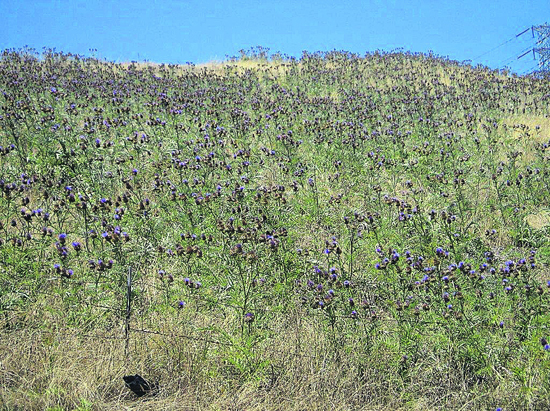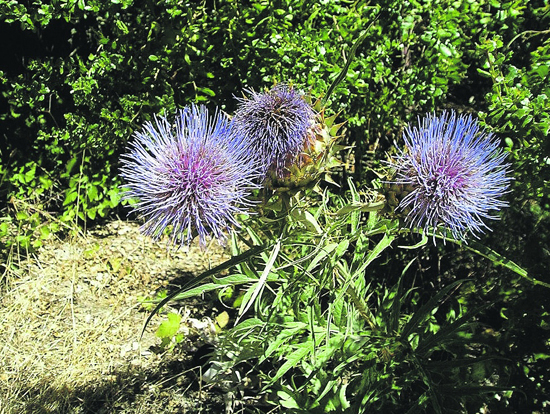| | Published August 17th, 2011
| As Thick as Thistles
| | Cathy Dausman |  | |
|
A swath of purple thistles covering a Lamorinda hillside makes a great photo op. To borrow a phrase from a Frank Baum character, the vista is quite "soothing to the eye". It turns out these weeds have more in common with the Wicked Witch than any good Oz character. The photo shows Cynara cardunculus, or artichoke thistles, says Contra Costa County Agriculture Commissioner Vince Guise. He said those thistles, plus "purple star, yellow star, and French and Scotch broom are major pests in the Lamorinda area."
 Artichoke thistle is the native Mediterranean plant from which the globe artichoke was developed, but you probably don't want to eat one. The thistles grow several feet tall and can spread to seven feet in diameter. Their needle-like spines are up to an inch-and-a-half long, and the blue flower measures up to six inches in diameter.
Artichoke thistle is the native Mediterranean plant from which the globe artichoke was developed, but you probably don't want to eat one. The thistles grow several feet tall and can spread to seven feet in diameter. Their needle-like spines are up to an inch-and-a-half long, and the blue flower measures up to six inches in diameter.
 Flowering takes place in June. After the flowers mature the plant goes dormant turning brown and black. The plant emerges again next winter. Seeds can last in the soil more than 20 years. To rid an area of artichoke thistle, its taproot must be dug out eighteen inches beneath the soil. Otherwise, it sprouts back. Eradication help from Mother Nature includes gophers and voles that will eat the thistle roots, and birds and squirrels that eat the seeds. Goats sometimes much on the plant tops but aren't brought in for grazing because they don't dig the out the taproot.
Flowering takes place in June. After the flowers mature the plant goes dormant turning brown and black. The plant emerges again next winter. Seeds can last in the soil more than 20 years. To rid an area of artichoke thistle, its taproot must be dug out eighteen inches beneath the soil. Otherwise, it sprouts back. Eradication help from Mother Nature includes gophers and voles that will eat the thistle roots, and birds and squirrels that eat the seeds. Goats sometimes much on the plant tops but aren't brought in for grazing because they don't dig the out the taproot.
 A 2009 Contra Costa County Department of Agriculture publication referenced surveying and treating thistle "on a 458 acre privately owned property called Palos Colorados located in Moraga." At the time the property was over half infested with artichoke and purple star thistle.
A 2009 Contra Costa County Department of Agriculture publication referenced surveying and treating thistle "on a 458 acre privately owned property called Palos Colorados located in Moraga." At the time the property was over half infested with artichoke and purple star thistle.
 The county agriculture department does have a thistle control/eradication program, but "the Lamorinda area is pretty much the hold-out epicenter [on infestation because] we have not had the resources to get on all the affected properties."
The county agriculture department does have a thistle control/eradication program, but "the Lamorinda area is pretty much the hold-out epicenter [on infestation because] we have not had the resources to get on all the affected properties."
 The California Invasive Plant Council out of Berkeley has more information on native weed control. Call (510) 843-3902 or log onto info@cal-ipc.org .
The California Invasive Plant Council out of Berkeley has more information on native weed control. Call (510) 843-3902 or log onto info@cal-ipc.org .

|
 | |
| | | | | | | | | | | Advertisement | | |
| | | print story
Before you print this article, please remember that it will remain in our archive for you to visit anytime.
download pdf
(use the pdf document for best printing results!) | | | Comments | | |
| | | | | | | | | | | | | | | | |



